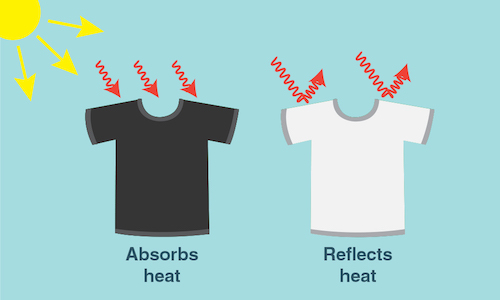19 Climate: Background Information
Climate is what happens USUALLY
Earth’s Atmosphere
Earth’s atmosphere is a layer of gases, mainly nitrogen and oxygen, between Earth’s surface and space. From space, the atmosphere can be seen as a thin blue line around Earth’s circumference in the image below.

The atmosphere is relatively thin, 60 miles wide, but it plays an important role for the planet. It lets in heat from the Sun so Earth has a livable temperature, while also acting a shield to block much of the Sun’s harmful radiation. When Earth’s systems are in balance, the atmosphere is a key part of regulating temperature, weather, and climate.
What is a greenhouse gas?
Certain gases in Earth’s atmosphere are called greenhouse gases. Like a greenhouse, they let sunlight through to reach the surface of Earth and then trap its heat in the atmosphere. The most abundant greenhouse gases are:
- Carbon dioxide (CO2)-Carbon dioxide is naturally released from decaying organisms and volcanic eruptions. However, humans are the main cause of excess carbon dioxide in the atmosphere from burning fossil fuels.
- Nitrous oxide (N2O)-Bacteria naturally produce nitrous oxide, but humans create more from industrial activities such as factory waste and agricultural products such as fertilizer.
- Methane (CH4)-Methane is naturally created in wetlands and oceans, but humans also contribute to excess methane through agriculture; cows release a significant amount of methane by burping when they digest their food.
- Water Vapor (H2O)-From the effects of climate change, there is more energy in Earth’s systems and the global water cycle. As the temperature increases, this causes more water to evaporate and enter the atmosphere as water vapor, a heat-trapping molecule.
- Ozone (O3)-High in the atmosphere, the ozone layer (naturally occurring ozone) blocks the Sun’s radiation and helps regulate Earth’s temperature. Lower in the atmosphere, however, human activities such as vehicle emissions create additional ozone. This ozone is bad because it traps heat in the atmosphere and creates smog.
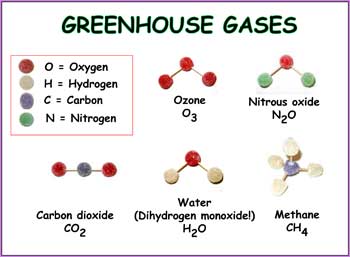
Greenhouse gases are complex molecules made of three or more atoms bonded together. Gases move quickly and collide with other molecules in the atmosphere. This causes greenhouse gas molecules to vibrate and have an asymmetrical shape.
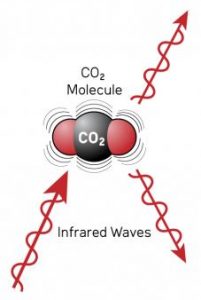
Because of this asymmetrical shape, they can absorb infrared radiation from the Sun. Then, the radiation is released back into the atmosphere which helps keep the planet warm enough to support life. Other gases in Earth’s atmosphere such as nitrogen and oxygen are more abundant, but they do not absorb infrared radiation because their molecular structure stays symmetrical.
The Greenhouse Effect
Watch the following video for a short explanation of carbon dioxide and the greenhouse effect.
Video Credit: “Earth’s Gas Problem” by NASA Global Climate Change is public domain
What is the greenhouse effect?
The greenhouse effect describes how greenhouse gases in Earth’s atmosphere trap heat.
When infrared radiation from the Sun reaches Earth:
- Some radiation is reflected back into space by the atmosphere and surfaces with a high albedo such as ice.
- Other radiation is absorbed by greenhouse gases and surfaces with a low albedo such as land and water.
- Absorbed radiation is later released as heat which increases Earth’s temperature.
Watch the animation, below, to see the greenhouse effect in action.
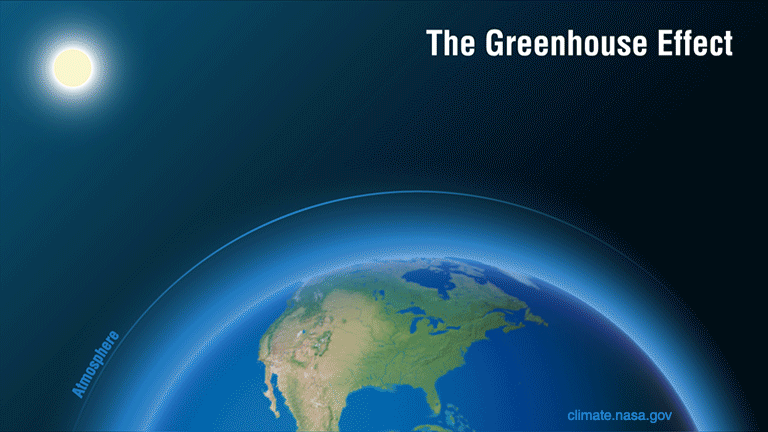
The greenhouse effect is a key part of Earth’s natural processes. Without heat from the Sun’s radiation and the atmosphere’s protection, Earth’s temperature would not be regulated to support life. However, the greenhouse effect can go too far when Earth’s systems are out of balance.
Earth’s atmosphere can be compared to a blanket that is wrapped around the planet; the planet needs this blanket to survive in outer space. But when there are too many greenhouse gases in the atmosphere (from burning fossil fuels, for example), they radiate more heat than normal. This causes Earth’s blanket to get thicker and thicker and global temperature increases. Unfortunately, Earth cannot simply take the blanket off in order to cool down. Over time, this leads to our current situation: global climate change with wide-reaching and serious consequences.
Albedo Effect
Albedo is the amount of energy reflected by a surface. Light surfaces tend to have a high albedo because they reflect more energy. Dark surfaces tend to have a low albedo because they absorb more energy.
As seen in the image, below, the Sun’s rays project solar radiation to Earth’s surface. Lighter-colored surfaces such as ice reflect the radiation. Darker-colored surfaces such as land and water absorb the Sun’s heat.

Currently, Earth’s albedo is decreasing as a result of climate change. As ice melts at the poles and glaciers, it is replaced by land and water. Because of their darker colors, land and water have low albedo–they absorb radiation which increases Earth’s temperature and leads to increased ice melt. This relationship, a positive feedback loop, is shown in the image below.
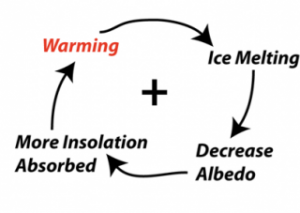
Key Takeaways
The Carbon Cycle
Carbon is an abundant element that is critical for life on Earth. As seen in the image, below, carbon naturally moves between the atmosphere, land, and water in the carbon cycle. Most of Earth’s carbon is stored in rocks and sediments, but also in the oceans and in the atmosphere.
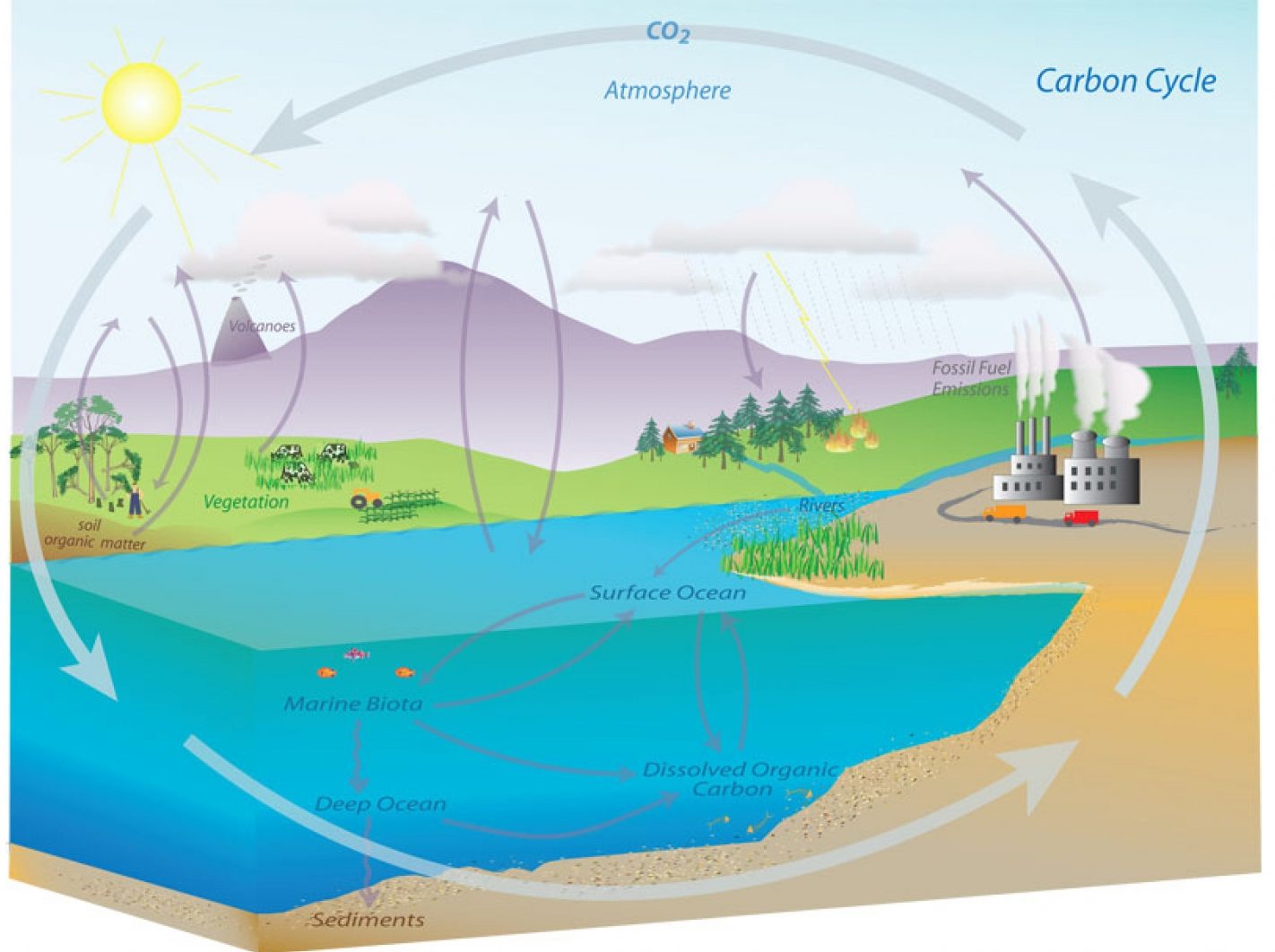
Carbon dioxide, a greenhouse gas, is important for life on Earth. For example, it traps heat to regulate Earth’s temperature and is a key component of photosynthesis, the process by which plants create their own food. Due to human activities, however, carbon dioxide is increasing to abnormally high levels in the atmosphere and causing Earth’s temperature to heat up.
The following video shows the global carbon cycle, how carbon dioxide in Earth’s atmosphere fluctuates and moves around the globe over the course of a year.
Video Credit: “A Year in the Life of Earth’s CO2” by NASA is public domain
What is ppm?
Carbon dioxide in the atmosphere is measured in parts per million (ppm).
So, if the CO2 concentration is 400 ppm, that means 400 molecules out of every one million gas molecules in the atmosphere are carbon dioxide.
Ice Cores
Scientists use ice cores, samples of ice drilled from ice sheets and glaciers, to gather data about carbon dioxide levels over time. The Law of Superposition and the Law of Original Horizontality can be applied to ice cores as well: Older layers of ice are compacted and trapped beneath newer layers over time. Within each layer, bubbles of carbon dioxide are trapped; this provides scientists with a record of atmospheric levels of carbon dioxide going back hundreds of thousands of years. Scientists can also use this data to create climate models which help predict future climate change.
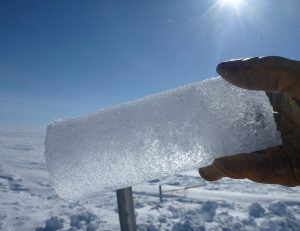
The graph, below, was created using ice core data. As shown in the graph, carbon dioxide levels on Earth have naturally fluctuated for hundreds of thousands of years. Still, CO2 levels were relatively stable within a certain range and never exceeded 300 ppm.
At the far right side of the graph, there is a sharp uptick in CO2 levels, indicating the rise of fossil fuel use. By 2017, the average was 405 ppm. NASA’s most recent data from July 2019 measured 411 ppm of CO2 in the atmosphere. All of this data indicates that Earth’s systems are out of balance from typical patterns that have been established over millennia.
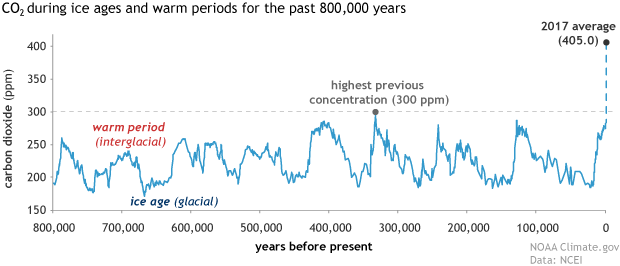
NGSS
| K-PS3-1. | Make observations to determine the effect of sunlight on Earth’s surface. [Clarification Statement: Examples of Earth’s surface could include sand, soil, rocks, and water.] [Assessment Boundary: Assessment of temperature is limited to relative measures such as warmer/cooler.] |
|---|
| K-PS3-2. | Use tools and materials to design and build a structure that will reduce the warming effect of sunlight on an area.* [Clarification Statement: Examples of structures could include umbrellas, canopies, and tents that minimize the warming effect of the sun.] |
|---|
| 5-ESS2-1. | Develop a model using an example to describe ways the geosphere, biosphere, hydrosphere, and/or atmosphere interact. [Clarification Statement: Examples could include the influence of the ocean on ecosystems, landform shape, and climate; the influence of the atmosphere on landforms and ecosystems through weather and climate; and the influence of mountain ranges on winds and clouds in the atmosphere. The geosphere, hydrosphere, atmosphere, and biosphere are each a system.] [Assessment Boundary: Assessment is limited to the interactions of two systems at a time.] |
|---|
| MS-ESS2-5. | Collect data to provide evidence for how the motions and complex interactions of air masses result in changes in weather conditions. [Clarification Statement: Emphasis is on how air masses flow from regions of high pressure to low pressure, causing weather (defined by temperature, pressure, humidity, precipitation, and wind) at a fixed location to change over time, and how sudden changes in weather can result when different air masses collide. Emphasis is on how weather can be predicted within probabilistic ranges. Examples of data can be provided to students (such as weather maps, diagrams, and visualizations) or obtained through laboratory experiments (such as with condensation).] [Assessment Boundary: Assessment does not include recalling the names of cloud types or weather symbols used on weather maps or the reported diagrams from weather stations.] |
|---|
| MS-ESS3-5. | Ask questions to clarify evidence of the factors that have caused the rise in global temperatures over the past century. [Clarification Statement: Examples of factors include human activities (such as fossil fuel combustion, cement production, and agricultural activity) and natural processes (such as changes in incoming solar radiation or volcanic activity). Examples of evidence can include tables, graphs, and maps of global and regional temperatures, atmospheric levels of gases such as carbon dioxide and methane, and the rates of human activities. Emphasis is on the major role that human activities play in causing the rise in global temperatures.] |
|---|
DCI
Kindergarten
PS3.B: Conservation of Energy and Energy Transfer
Fifth Grade
ESS2.A: Earth Materials and Systems
middle school
ESS2.D: Weather and Climate
ESS3.D: Global Climate Change
Crossscutting
middle school
Systems and System Models
The typical weather conditions in an area over a 30-year period.
The amount of energy reflected by a surface. Light surfaces tend to have a high albedo because they reflect more energy. Dark surfaces tend to have a low albedo because they absorb more energy.
Finite sources of energy derived from ancient remains of decomposing organisms. The main fossil fuels are coal, oil, and natural gas.
A significant change over a 30-year period from the typical or expected weather patterns of an area. Modern climate change is human-caused.
A process where one change triggers the next in a continuous cycle that encourages the initial change.
Deeper layers of rocks are older than layers closer to the surface.
Due to the pull of gravity, new rock is initially formed in flat, horizontal layers.
Parts per million; a unit of measurement for carbon dioxide and other gases in the atmosphere.

